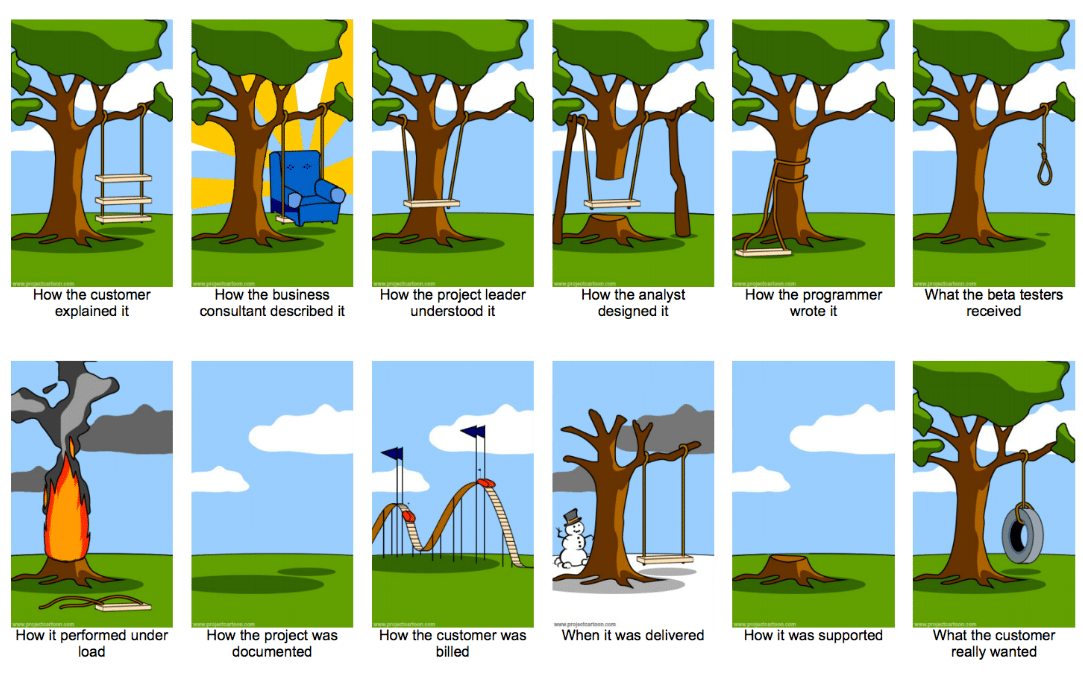If you want to understand some of the pitfalls of product management, take a look at this cartoon. It gets me every time because it’s so spot-on. While it might seem like an irrationally complex path to the simple tire swing, it’s true that companies often miss the mark when trying to understand a customer’s requirements. Generally speaking, the problem comes down to one thing: not getting the right customer feedback.


Getting customer feedback is important because if you don’t gather feedback, you’re building a product in a vacuum. But getting the right feedback is crucial because it’s how you find out what the customer really wants, not just what they say they want. As an experienced product manager knows, those two things are often different.
Build out your entrepreneur toolbox and upgrade to Crunchbase Pro.
Six most common issues to avoid when gathering customer feedback
There are plenty of ways to get useful feedback, but there are also just as many ways to ignore or misread your customer’s input instead of letting it guide you to the answer. Here are six of the most common issues to avoid when gathering customer feedback:
1. Having strong assumptions—and not testing them
You assumed the customer would know what to do when they opened up your app. You assumed they were working with the newest iPhone and the latest version of Google Chrome. But it turns out, they couldn’t use your app because they’re using an iPhone 5s, and they prefer Internet Explorer.
Your assumptions will always derail your mission to get customers what they truly want.
The only way to keep your product on track is to test your assumptions by asking customers questions. How do they use the product? What platform do they use?
Find out what products a company uses and add G2 Stack data directly in Crunchbase.
How much do they know about this industry and product domain? You should validate your assumptions and use the learnings to inform what you’re building. Talk to your customers. Check out your analytics of how they use the app. Sit in on customer support calls. You can even keep an eye on sales inquiries, as that will give you a better idea of what the customer is looking for.
It’s fine to have assumptions—that’s a normal part of any product development process. But when you refuse to test them and change with the results, you’ll run into trouble.
2. Being judgmental toward customers
It’s easy to get frustrated or annoyed with a customer when they don’t understand the product.
Maybe you think they should get it, but that’s beside the point. As a user, they need to actually be able to work with your product. And it’s your job to make it easier for them.
I recently ran into this situation with some of our customers at Chronicled when they had to manually update files. It caused major frustration for all. We assumed our customers knew more about the underlying technology than they did. But instead of blaming them for not having technical skills or not wanting to do the tedious work, we came up with a way to automatically generate the files and eliminate the avenues for mistakes.
Even if you know how to use a product, that doesn’t mean it’s simple enough for customers to use.
3. Getting defensive
You have to be empathetic if you want to understand what your customers are telling you. Getting defensive when customers complain only means you’ll be unable to see their point of view and properly solve their issues.
Instead of pointing fingers, ask the following questions:
Why are they getting into a problematic situation?
Why do they feel it isn’t working for them?
How could you do a better job to make their work easier?
If they say your product is not compatible with their systems, for example, don’t dismiss it. Start diagnosing their problem and trying to find the root cause in order to make them successful. Act as an advisor wanting to solve a problem for them instead of just trying to sell them something.
4. Missing common patterns and becoming reactive.
When you miss patterns in customer feedback and end up creating custom solutions, you risk becoming a custom service shop.
What often happens is, you have 100 different problems—from multiple customers. If you’re strictly reactive, you’ll end up trying to create 100 different solutions. But that process doesn’t scale, and it requires a massive (and expensive) workforce.
“After getting feedback from customers about why they’re experiencing problems, find the patterns within those problems and solve them using common solutions.”
What you really want is a common solution that many customers can use. After getting feedback from customers about why they’re experiencing problems, find the patterns within those problems and solve them using common solutions. This keeps your product generic and usable for many customers without constant customization.
You have to be customer-focused while ruthlessly prioritizing and ensuring you’re working on issues you can develop a future around, rather than constantly building one-off solutions.
5. Misjudging priorities and urgency.
Let’s say a customer calls you up and shares 10 different problems they’re having with your app. I know the temptation is to drop everything to get all 10 problems fixed for that one customer, but you can’t drop your whole product load to deal with a single client.
That simply isn’t sound practice, and you’ll never get anywhere doing that.
The reality is, you have limited resources to deal with this. You can’t immediately fix them all, so you prioritize them based on the urgency of the issue. In fact, you may find that after solving the three most urgent problems, the others become irrelevant or the customer is less worried.
6. Misreading your customer.
Generally speaking, you’ll have three types of customers.
- Early adopters are your first wave, and they like trying new technology first.
- Then early majority comes—the general population who try out something that is tested and dependable.
- Finally, the late majority arrives. They’re the ones lagging behind, who try to avoid new technology.
Each group is very different and so are their needs. If you only get customer feedback from one group, such as the early adopters, you’re going to get insight into a completely different set of requirements than the early and late majorities. And if you stop getting feedback after you think you’ve found what works for the early adopters, you’re actually going to get stuck in the chasm, between early adopters and the early majority—and likely fail there.
Nothing beats good feedback when it comes to building a great product. Truthfully, the difference between getting strong feedback and stifling it comes down to you.
Ajit is the VP of Product at Chronicled. He has almost a decade of experience in the media and entertainment space and has worked as a product manager and software engineer on products that enable service providers to deliver their content on any screen at any time. He earned his MBA from the University of California, Berkeley.






